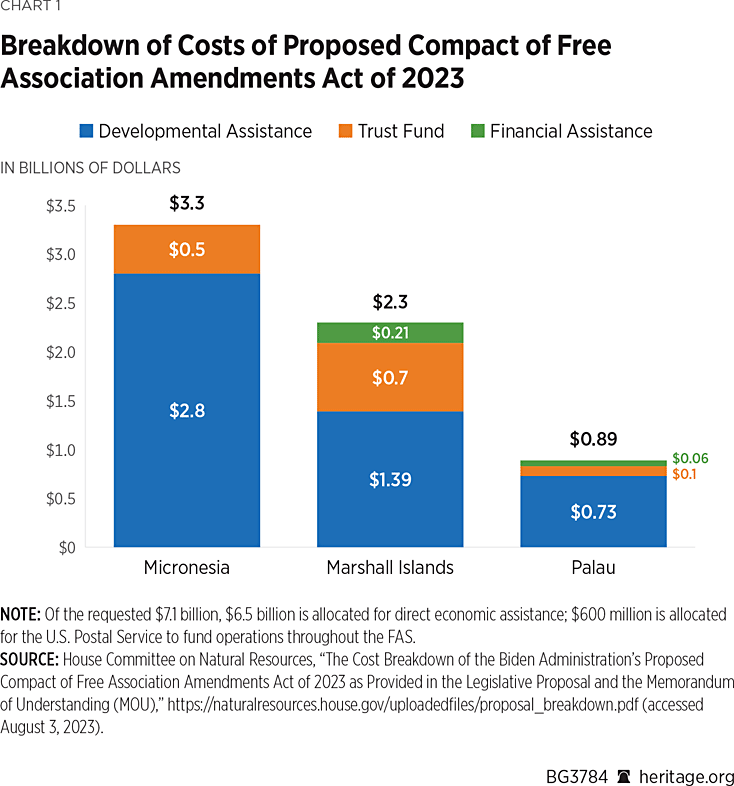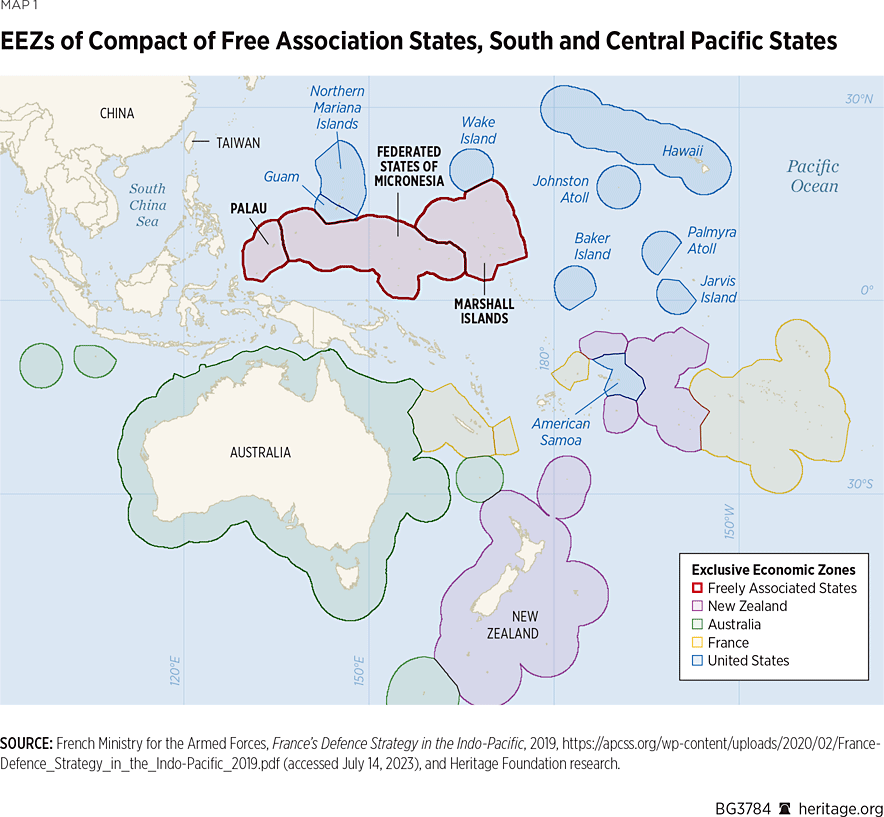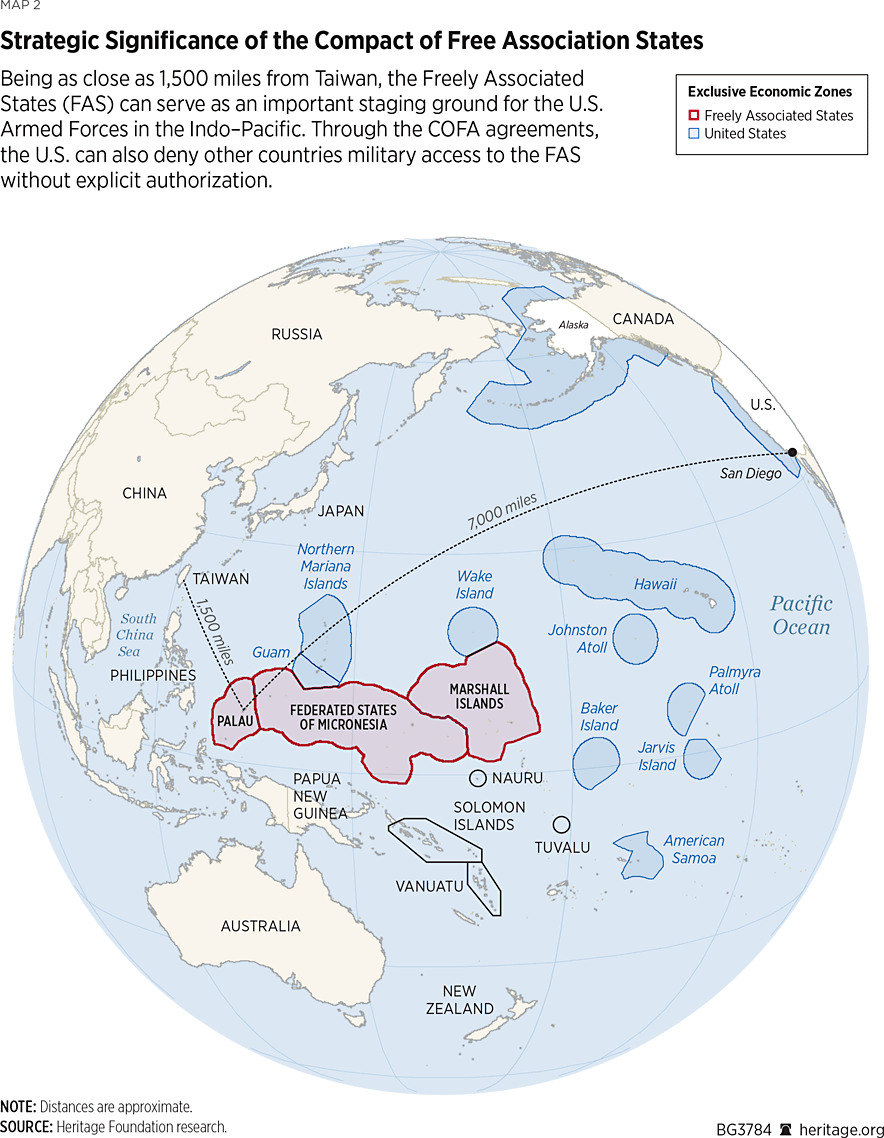The New Cold War between the United States and the People’s Republic of China (PRC) has renewed attention on the Pacific Islands’ enduring strategic relevance for U.S. national security.REF The United States has maintained a robust presence in the Pacific since the end of World War II, and since the 1980s, America’s Compacts of Free Association (COFA)—unique bilateral agreements with three Pacific Island nations—have been the most important element of U.S. foreign policy in the region.REF
Various provisions of the COFA agreements with the Federated States of Micronesia and the Republic of the Marshall Islands are set to expire on September 30, 2023, while provisions with the Republic of Palau will expire on September 30, 2024.
Failing to renew and fund the unique COFA agreements could result in the eventual loss of exclusive U.S. military access to these three states and open the door for the PRC to expand its influence in the region even further.REF In April 2022, the PRC signed a security agreement with the nearby Solomon Islands, with the two sides updating the agreement in July 2023.REF Additionally, in May 2022, Chinese foreign Minister Wang Yi visited eight Pacific Island states in 10 days, although he was unable to secure a multilateral agreement that would have deepened Chinese security and economic ties in the region.REF With the September deadline fast approaching, Congress faces a once-every-two-decades opportunity to renew and fund the COFA agreements and secure America’s privileged position in the Pacific.
Background
The COFA agreements between the United States and Micronesia, the Marshall Islands, and Palau govern defense, economic, and diplomatic relations. Collectively known as the Freely Associated States (FAS), Micronesia, the Marshall Islands, and Palau entered a special association with the United States when the first Compacts were signed into law during the Reagan Administration on November 13, 1986.
Previously, the FAS were part of the Trust Territory of the Pacific Islands, which was administered by the U.S. from 1947 to 1994. The trusteeship ended after Palau established its independence in 1994. While most provisions of the COFA agreements have a 50-year lifespan, various economic provisions were set to expire after 20 years. Accordingly, COFA agreements for Micronesia and the Marshall Islands were renewed and funded for 20 years through the Compact of Free Association Amendments Act of 2003. Amendments to Palau’s COFA agreement were most recently made in 2018 and expire in 2024.
An experienced career diplomat, Ambassador Joesph Y. Yun, was announced as the Special Presidential Envoy for Compact Negotiations in March 2022. In May 2023, the United States and Palau signed an agreement laying the groundwork for renewing their COFA agreement once again.REF The same month, the U.S. and Micronesia signed three COFA-related agreements: (1) an Agreement to Amend the Compact, as Amended; (2) a new Fiscal Procedures Agreement; and (3) a new Trust Fund Agreement.REF COFA negotiations with the Marshall Islands are ongoing, though the Marshall Islands’ cabinet has confirmed its agreement with the $2.3 billion memorandum of understanding signed in January 2023.REF
Funding
In June 2023, the Biden Administration submitted a legislative proposal, the Compact of Free Association Amendments Act of 2023, to Congress.REF The act requests $7.1 billion over 20 years to financially support the COFA agreements. Congress must re-authorize the COFA agreements in law.REF The draft legislation would provide roughly $350 million per year in economic assistance across the FAS. Of the $7.1 billion, $6.5 billion is allocated for direct economic assistance and around $600 million is allocated for the U.S. Postal Service to fund operations throughout the FAS. For perspective: The total funding request for 20 years is less than one-tenth of the total U.S. assistance authorized for Ukraine since February 2022.REF
The proposed $6.5 billion is divided as follows: Micronesia receives $3.3 billion, the Marshall Islands receives $2.3 billion, and Palau receives $889 million.REF When adjusting for inflation, the proposed agreement continues stable funding that is roughly comparable to the current COFA agreements.REF The majority of these funds are divided into development assistance, trust fund, and financial assistance provisions.

Key Provisions
The COFA agreements provide the U.S. and the FAS unique benefits:
Defense Exclusivity. The COFA agreements grant the U.S. full authority over FAS defense matters and allow the U.S. exclusive rights to “establish and use military areas and facilities” within FAS territories.REF This allows the U.S. to conduct military exercises and station military personnel at will. The FAS also must refrain from actions that interfere with U.S. security decisions, including within their own territories. The FAS have also hosted a variety of regional military exercises, including the Task Force Koa Moana, Cope North, and the Pacific Partnership.REF
Strategic Denial Rights. The COFA agreements grant the U.S. strategic denial rights. The United States may “foreclose access to or use of” the FAS “by military personnel or for the military purposes of any third country,”REF meaning that military forces and personnel of any other state can enter FAS territory only if the U.S. has explicitly authorized their entry. So, the U.S. can prevent Chinese vessels from docking in or visiting FAS ports. Additionally, through the exclusive Compacts, the U.S. can prevent China from visiting ports within the majority of Micronesia, making it more complicated for the People’s Liberation Army Navy to deploy forces or conduct operations in the region.
Economic and Program Assistance. In return, the FAS receive economic aid and access to some U.S. federal programs, generally delivered through trust funds. Annual grant assistance covers various educational, health, private-sector, public-sector, and environmental programs. These include Pell Grants, limited immigration pathways, U.S. national weather and emergency services, opportunities to serve in the U.S. Armed Forces, and Veterans Affairs.REF Palau, for example, has a higher per capita rate of volunteers serving in the U.S. Armed Forces than any U.S. state.REF
U.S. Responsibilities
Through the COFA agreements, the U.S. is obligated to provide support for important FAS-related matters:
Security and Defense. The FAS do not have their own militaries, and the U.S. is responsible for defending the territorial integrity of the FAS and responding to illegal activities within FAS territories, which include territorial seas and air spaces. The FAS’ combined exclusive economic zones (EEZs) cover a maritime area more than half the size of the continental United States. With Guam, the Northern Marianas Islands, American Samoa, Hawaii, and the FAS, the United States holds sway over about one-third of available EEZs in the Pacific Islands.REF The vast territory is difficult to cover. The U.S. Coast Guard’s (USCG’s) Fourteenth District, with 1,150 active-duty personnel and 25 operational units, is responsible for more than 14 million square miles of land and sea, including Hawaii, Guam, American Samoa, and activities in Saipan, Singapore, and Japan.REF With boundaries of responsibility stretching from the Hawaiian Islands to the Central and Western Pacific, the Fourteenth District is the USCG’s largest area of responsibility.REF When requested by the FAS, the USCG intercepts and escorts foreign vessels, provides emergency services in this region, and responds to illegal, unreported, and unregulated (IUU) fishing activity.REF

Nuclear Legacy. Following World War II, the Trust Territory of the Pacific Islands was used by the United States for nuclear weapons testing. The 1954 Castle Bravo test, the largest U.S. bomb ever tested, occurred at Bikini Atoll in the Marshall Islands. The U.S. “accepts the responsibility for compensation owing to citizens” of the FAS “resulting from [its] nuclear testing program.”REF The U.S. is responsible for multiple resettlement, clean-up, and payment efforts for atolls primarily concentrated in the Marshall Islands. Section 177 of the original COFA legislation in 1986 authorized $150 million in compensation for the Marshall Islands for nuclear testing, which the U.S. Congress intended to be the “full and final settlement of all claims” described in the section. In 2000, the Marshall Islands submitted a Changed Circumstances Petition to receive additional compensation.REF In 2004, the U.S. Department of State concluded that the Marshall Islands’ request lacked legal basis for additional compensation.REF
That said, some Compacts assistance is specifically allocated for environmental projects related to nuclear legacy issues. The Cactus Crater containment structure, also known as the Runit Dome, is an 18-inch-thick concrete dome within a 328-foot crater and holds an estimated 73,000 cubic meters of radioactive soil.REF The U.S. is responsible for a visual study and radiochemical analysis, with the results included in a Department of Energy report published at least every four years.REF
Environmental Resilience. The U.S. has provided funds for the clean-up and economic development of the Bikini and Kwajalein Atolls in the Marshall Islands, respectively, which are contaminated with radioactive waste, heavy metals, and pesticides.REF The COFA agreements ensure that funds are available to sustain infrastructure and defense facilities in the event of rising sea levels or dangerous storms.
Strategic Advantages
The COFA agreements provide the United State geostrategic benefits in countering Chinese ambitions and solidifying its position in the Pacific.
Geographic Relevance. The FAS reside within the Micronesia subregion of Oceania. This region also includes Guam and the Northern Mariana Islands—both U.S. territories. Collectively, these states and territories comprise and extend westward deeper into the Pacific than any other U.S.-controlled territory, with Palau’s EEZ abutting that of the Philippines. In case of a military contingency in the Indo–Pacific, such as a Chinese attack on Taiwan or a conflict on the Korean peninsula, the U.S. would require easy access and transit through the central Pacific, where the FAS serve as important staging grounds or, in a dire situation, a fallback location. For context, Palau is fewer than 1,500 miles from Taipei, while Hawaii is more than 5,000 miles from Taipei, and California is nearly 7,000 miles away.
Palau will host a $118 million foundational installationREF to support the Tactical Multi-Mission Over the Horizon Radar (TACMOR) system,REF which is expected to be operational by 2026. Micronesia will facilitate Agile Combat Employment (ACE) for the U.S. Air Force,REF a “proactive and reactive operational scheme of maneuver” that “shifts operations from centralized physical infrastructures to a network of smaller, dispersed locations that can complicate adversary planning” and “hold adversary targets at risk from multiple locations.”REF The Marshall Islands also host the U.S. Army Garrison Kwajalein Atoll and the Ronald Reagan Ballistic Missile Defense Test Site.REF Palauan President Surangel S. Whipps, Jr., stated that Palau is within a five-hour—presumably direct—flight to “every major city in Asia.”REF Should Guam come under sustained attack, supporting regional military operations will necessarily shift to the FAS.

Changing Security Environment. In 2022, the PRC and the Solomon Islands signed a security agreement. While the two sides have kept the final terms secret, a leaked draft indicated that the PRC would have wide latitude to undertake military activities in the Solomon Islands “according to its own needs.”REF Even if the PRC’s claim is credible that it will not “station troops or build military bases,”REF the signing of the agreement demonstrated PRC intentions and ambitions to expand its security footprint in the Pacific Islands. In addition to the United States and Papua New Guinea signing a Defense Cooperation Agreement (DCA) in May 2023, which grants the U.S. access to airfields and ports, the COFA agreements remain irreplaceable elements of the United States’ advantage in military access to the region as the PRC grows bolder.REF
Malign PRC Influence. The PRC is actively attempting to influence the FAS and Pacific Islands in a manner that runs counter to U.S. interests.REF Notable examples include:
- In March 2023, former Micronesian President David Panuelo released a 13-page letter detailing Chinese efforts to bribe Micronesians and influence decision-making. Examples include the PRC threatening Panuelo’s personal safety, inviting private citizens—cutting out public officials—to formally represent Micronesia in official government meetings with the PRC, and attempting to influence Micronesia to align with the PRC during a Taiwan-related military contingency.REF
- Recent PRC efforts to isolate Taiwan have been successful: The Solomon Islands and Kiribati switched diplomatic relations to the PRC in 2019.REF
- Chinese fishing vessels continue to engage in IUU fishing and threaten the vital fishing economies of the FAS with no regard for environmental or ecosystem impacts.REF The PRC is even naming underseas ridges within Palau’s EEZ and claimed extended continental shelf with Chinese names.REF
- Between 2013 and 2016, Palau saw Chinese tourists go from “zero to 70 percent of [its] market” and contribute to a 30 percent increase in gross domestic product.REF After Palau’s 2016 presidential election, the PRC effectively blocked Chinese tourists from visiting Palau.REF With Palau’s 2024 presidential election approaching, the PRC is seemingly sponsoring chartered flights to Palau.REF
- In 2023, a Chinese research vessel conducted “questionable maneuvers” over Palau’s undersea fiber optic cable that links it to the Internet and telecommunications.REF
- An expatriate Chinese hotelier entered into a deal with a Palauan newspaper with intentions to spread pro-Chinese content and expand Chinese influence operations in Palau.REF The Chinese stakeholder “sent the paper the full text of a story publicising a recent visit by Chinese diplomats to meet politicians in Palau,” describing the trip as Palau’s “highest officials openly supporting change of diplomatic ties from Taiwan to China.”REF The Overseas Chinese Big Data Group, the largest shareholder of the Palau Media Group at 40 percent when it was founded in 2018, has ties to the Chinese police and military, including the Chinese People’s Public Security University and People’s Liberation Army Strategic Support Force Information Engineering University.REF Despite direct editorial influence appearing to be “short-lived,” the effort was “a successful attempt to influence prominent Palauans.”REF
- While Pacific Island states have consistently voted with the U.S. in the United Nations, ongoing PRC influence operations, especially without the COFA agreements, may slowly peel off the reliable voting bloc from the U.S. and make it more difficult for the U.S. to secure its interests in the United Nations.REF Likewise, should the COFA agreements not be renewed, the FAS would have few domestic policing vessels for defense against any Chinese maritime vessels that enter FAS territories. Additionally, the Marshall Islands and Palau may face even stronger PRC influence operations aimed at compelling them to end their diplomatic recognition of Taiwan.REF
Recommendations for the United States
To renew and fund the COFA agreements:
- Congress should renew and fund the COFA agreements with Micronesia and Palau by September 30, 2023. This will secure two of the three COFA agreements for 20 more years at a crucial time to safeguard Pacific alliances in the face of PRC ambitions.
- The United States and the Marshall Islands should continue good-faith negotiations to agree to, sign, and fund a renewed COFA agreement by September 30, 2023. The U.S. and the Marshall Islands both have strong interests in renewing their COFA agreement. The COFA agreement is too important for both states not to reach an agreement. It is also possible for the U.S. and the Marshall Islands to consider new programs, separate from the Compact, that can address outstanding concerns related to certain provisions.REF
- The U.S. Indo–Pacific Command (USINDOPACOM) should prepare infrastructure project proposals. In the event that Congress cannot take legislative action on the COFA agreements before September, USINDOPACOM should prepare stopgap measures. U.S. Naval Construction Battalions, known as the Navy Seabees, could propose constructing dual-use facilities, such as pier expansion and dredging, resilient power generation, and expanding airfields in FAS territories. The Seabees or the U.S. Army Corps of Engineers could also construct medical facilities that use radiology for diagnosing and treating diseases. This would be, however, at best a short-term fix.
- Congress should align discretionary foreign assistance spending with Indo–Pacific priorities. Despite multiple Administrations identifying the Indo–Pacific as the most important region in the New Cold War with the PRC, the Indo–Pacific consistently receives less than 10 percent of total U.S. foreign assistance each year.REF This failure to appropriately align foreign assistance spending with current national security threats contributes to the difficulty in funding the Compacts. This year’s House Republican foreign assistance appropriations bill has begun to address this problem and includes partial COFA funding.REF Congress should make the Indo–Pacific a priority and fully fund the Compacts, which will likely require judgment calls about secondary priorities that place disproportionate strain on foreign assistance appropriations. For example, between April 2021 and March 2022, the U.S. gave the Palestinian people more than $500 millionREF and, between August 2021 and September 2022, provided Afghanistan more than $1.1 billion.REF Furthermore, during fiscal year 2022, the U.S. was obligated to provide more than $200 million to VenezuelaREF and $150 million to Pakistan in foreign assistance funds.REF
To bolster partnerships in the Pacific Islands:
- The U.S. should explore the possibility of new COFA agreements or DCAs in the region. The COFA agreements have proven to be strategically valuable for securing U.S. interests at an acceptable cost. With the PRC making inroads into the Pacific Islands, new COFA agreements or DCAs with other Pacific Island states would not only protect more of the region against further PRC military expansion but could also provide the U.S. additional military flexibility to respond to PRC activities and malign influence in the Pacific. Kiribati, Nauru, and Tuvalu are possible candidates.REF
- The U.S. President should tour the FAS. No U.S. President has ever visited a Pacific Island state—despite having defense commitments with three of them and visiting every other Indo–Pacific state with which the U.S. has a defense commitment. Although President Joe Biden’s planned trip to Papua New Guinea in 2023 was cancelled, he, or a future President, should schedule a new trip to tour the FAS.REF Top U.S. officials, including the Secretary of State, should plan more regular visits to the region.
- The U.S. should explore helping the FAS to establish and sustain national security councils. The Pacific Partnership Strategy of the United States identifies numerous security issues confronting the FAS, including IUU fishing, environmental disasters, drug trafficking, and endangered coastal safeguards.REF More recently, the PRC has used research vessels to probe the EEZs of the FAS.REF With the U.S. Armed Forces operating within their territories, establishing national security councils in the FAS could improve coordination between the U.S. and local officials, boosting emergency preparedness. Palau already has a national security council, while Micronesia and the Marshall Islands are each considering establishing their own.REF The U.S. can offer support, such as communications equipment and intelligence sharing, to all three COFA states.REF The U.S. would maintain its legal authorities in ultimately determining defense actions within the FAS.
- The U.S. Department of Defense’s State Partnership Program (SPP) should form new partnerships with the FAS. The SPP is a security-cooperation program managed by the National Guard Bureau and sourced from the National Guards of various U.S. states and territories.REF Examples of cooperation include cooperative training and exercises, disaster response, leadership development, aviation operations, cyber defense, and communications security.REF As of May 2023, the only Pacific Island states involved with the National Guard SPP are Fiji, Papua New Guinea, Samoa, Timor-Leste, and Tonga.REF Expanding the SPP to FAS police forces could provide capacity-building efforts for Pacific Island partners and further expand cooperation with the FAS at a state level.
- The U.S. should work with allies and partners to improve the FAS’ infrastructure. U.S.-led infrastructure projects demonstrate that the FAS have alternatives to the PRC that offer high-quality and transparent infrastructure projects without the costs associated with the PRC’s malign influence. The East Micronesia Cable, an undersea cable that will connect the islands of Kiribati, Micronesia, and Nauru to the existing HANTRU-1 cable landing point in Micronesia’s capital of Pohnpei, is a good example of how the United States, along with Australia and Japan, can support Pacific Island communities and economies long term.REF A technical assistance grant from the U.S. Trade and Development Agency to support the Palau National Communications Corporation will modernize Palau’s telecommunications network, including the Quad-endorsedREF deployment of the Open Radio Access Network.REF Palau is also interested in joining the Blue Dot Network for infrastructure certification.REF The U.S. government should encourage the Development Finance Corporation, the U.S. Agency for International Development, and private entities to prioritize funding sound infrastructure in the COFA states. Such projects would require the approval of the respective FAS government.
To prioritize the Pacific Islands:
- The National Security Council (NSC) should re-establish the position of Director of Oceania & Indo–Pacific Security. The Trump Administration first established a dedicated NSC directorship covering the Indo–Pacific region, first held by Alexander Gray, but the Biden Administration merged it into the position of Director for Southeast Asia and the Pacific Islands. The Pacific Island portfolio should be separated from Southeast Asia due to its distinct security and political circumstances that, despite some similarities, are separate and require attention that cannot be adequately balanced with various Southeast Asian affairs.
- Congress and the U.S. Department of State should consider establishing a Deputy Assistant Secretary for the Pacific Islands (DASPI). The U.S. has recently increased its engagement in the Pacific Islands, meaning that additional attention to, and management of, existing and future commitments will be necessary.REF Currently, the Deputy Assistant Secretary in the Bureau of East Asia and Pacific Affairs responsible for the Pacific Islands also oversees relations with Australia, Japan, Mongolia, New Zealand, and South Korea.REF The DASPI would focus on policy and diplomacy efforts for all Pacific Islands, including managing FAS-related affairs and facilitating any new states that may be interested in entering into a Compact with the United States. The Office of Australia, New Zealand, and Pacific Islands would report to the DASPI. The DASPI, therefore, would more closely model the Deputy Assistant Secretary responsible for the Office of Mainland Southeast Asia Affairs and the Office of Maritime Southeast Asia Affairs.REF The DASPI would report to the Assistant Secretary of State for East Asian and Pacific Affairs.
Conclusion
The Pacific Islands are a core, if little-known, component of America’s Indo–Pacific strategy. As the PRC’s military capabilities grow to match its ambitions, the region will only become more contested and take on greater strategic importance for both the U.S. and China. Congress should not let this once-every-two-decades opportunity to renew and fund the COFA agreements slip away. At a reasonable price tag, the U.S. can advance its Indo–Pacific interests, reaffirm its commitment to Pacific Island allies, mitigate the PRC’s attempts to expand its influence, and tilt the regional balance of power in its favor.
Andrew J. Harding is a Research Assistant in the Asian Studies Center at The Heritage Foundation.



